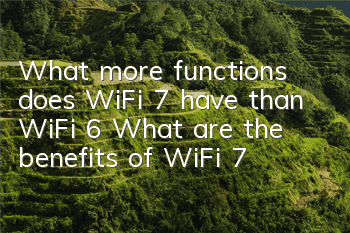What improvements does the WiFi 7 standard under development have compared to WiFi 6?
Devices that support Wi-Fi 6/6E have not yet become popular, and the next generation of Wi-Fi technology has appeared on the horizon. The Wi-Fi 7 (a.k.a 802.11be) standard has been released. At the same time, Qualcomm and MTK have released samples that support it, and Intel will also support it in the MeteorLake SoC Tile. As the seventh generation Wi-Fi technology, it comes from the Wi-Fi alliance EHT (Extremely High Throughput) protocol group, so it is sometimes called Wi-Fi EHT. As the name suggests, there is no doubt that improving throughput is the biggest highlight of Wi-Fi 7: The maximum throughput of single Link is 3.6 times that of the previous generation of Wi-Fi 6/6E! Among them, the PHY part is 2.4 times and the MAC part is 1.5 times. Multiply the two 2.4 X 1.5 = 3.6. In addition, channel utilization, QoS, delay and power consumption are all improved. How are these numbers obtained and what are the specific improvements? Let’s take a look at it in detail below.
Background knowledge
Since the brand promotion of Intel Centrino, Wi-Fi technology has gradually entered thousands of households. Centrino's small stickers and its brand marketing have become a legendary brand marketing case that is ranked alongside "Intel Inside", and are talked about by the Waiting Party. In addition to business intelligence, the maturity and continuous evolution of Wi-Fi technology have contributed to the great success.
Since the fall of 2018, the Wi-Fi Alliance introduced new naming rules, and since then, the obscure 802.11xx no longer bothers the majority of users, and instead uses clear and easy-to-understand digital encoding. After all, 6 is better than 5, and everyone knows that ax is better than ac, which makes ordinary people crazy. At that time, the latest 802.11ax was officially crowned Wi-Fi 6, while the previous two generations (802.11ac and 802.11n) were posthumously blocked Wi-Fi 5 and Wi-Fi 4. Later, Wi-Fi 6E (802.11axe) introduced the 6GHz band:
According to statistics, in 2021, more than 70% of devices will transmit data through Wi-Fi in home use scenarios, and more than 50% of IP communication is based on Wi-Fi. The strong demand, coupled with the increase in home office demand brought about by the raging coronavirus, has driven Wi-Fi to evolve faster and meet the challenges brought by growing applications. This is also an important reason why Wi-Fi 7 is proposed so quickly.
Wi-Fi 7 can be regarded as Wi-Fi-Fi 6 and Wi-Fi 6E have been merged and improved. Before introducing the details, let’s first introduce three concepts that are often confused when Wi-Fi technology: Band (band), Channel (channel) and Stream (data stream), and make some clarifications. We commonly use Wi-Fi bands (Bands) have three, 2.4GHz, 5GHz and 6GHz. They are becoming wider and wider in turn (60MHz, 500MHz and 1.2GHz), but at the same time the transmission distance and ability to bypass obstacles are weakening. We can compare Band to different highways: they are country roads, ordinary roads and city main roads. The roads need to be divided into lanes, and the Channel is the width of the lane, from the width of the pedestrian (20MHz) to the width of the ultra-wide special vehicle (320MHz). The width of the road determines how many lanes can be drawn into each lane. Although three sidewalks can be drawn on the country road, one large lane must not be placed; while the main road of the city is more than enough to put down three super-large lanes. Stream is the length of a vehicle running in the lane, which can be an ordinary car (2x2), a bus (3x3), or an extended bus (4x4). Obviously, when a lengthened and widened bus travels on an ultra-wide lane, it can run more cargo, that is, it can transmit more data, or have a larger throughput. Only by understanding this can you understand the following calculations about throughput.
Improvements of Wi-Fi 7 PHY
The biggest change in the PHY part to improve throughput is the addition of 320MHz Channel support and modulation mode to support 4K QAM. 16 x 16 data stream MU-MIMO can improve the theoretical maximum throughput upper limit, and Multi-RU can improve channel utilization.
320MHz Channel
Wi-Fi 7's maximum supported channel Channel width doubles from 160MHz of Wi-Fi 6/6E to 320MHz. It is so big that only 3 ultra-wide bandwidths of 1.2GHz in the 6GHz band:
The 320MHz channel width can be 1 320MHz or two 160MHz. 320MHz directly doubles the theoretical speed of a single data stream (Stream) and doubles from 1.2Gbps in Wi-Fi 6/6E to 2.4Gbps, providing twice the throughput.
4K QAM
QAM (Quadrature Amplitude Modulation) is a Wi-Fi signal modulation method, which modulates signals from both amplitude and phase. Wi-Fi 7 modulation mode is upgraded from 1K QAM to 4K QAM (some non-standard Wi-Fi 6 supports 4K QAM):
Although it requires higher channel quality, it is obvious to improve channel throughput. In theory, it can increase by 20%, which is the data given by Intel that combines 320MHz Channel and 4K QAM:
Combining Channel widening and modulation methods, the improvement of PHY can increase the throughput by 2.4 times for a single data stream. This may be more abstract, taking our life scenes as an example. Our mobile phones usually have two antennas, Stream 2x2, and the theoretical value of throughput has been increased from 2.4Gbps to 5.76Gbps:
Other improvements
Wi-Fi 7 increases the maximum data stream supported by MU-MIMO from 8 to 16, which theoretically doubles the overall throughput! But in fact, our ordinary equipment has two antennas, and there is no guarantee that there are no devices with 8 antennas. I have never seen them before, so it is more practical to improve the throughput of a single Stream. The maximum 16 Streams are useless for single-device throughput, but they can increase the number of devices served by access points at the same time, which meets the needs of more and more access devices now. In conjunction with the newly introduced CMU-MIMO (C stands for Coordinated) of Wi-Fi 7, 16 data streams can be provided jointly by different access points.
Multi-RU (MRU) is a technical point for the greater improvement of PHY part. Although it has little effect on improving single Stream throughput, it can better utilize the channel. RU (resource unit) is the minimum resource unit (Non-AP STA) for communication allocation, which can solve the problem of wasting channels in small amounts of data transmission. As the underlying technology behind OFDMA (Othogonal Frequency Division Multiple Access) and MIMO, it is still a single RU allocation in Wi-Fi 6. The introduction of MRU this time can provide flexible RU combination forms to make full use of channel resources.
Wi-Fi 7 MAC improvementMLO (Multi-link Operation)
MLO personally considers it the most useful part of the many new features of Wi-Fi 7. Wi-Fi now supports 2.4GHz, 5GHz and 6GHz, but only one can be connected at a time. It needs to be switched manually, and two cannot be connected at the same time. There are now some non-standardized methods to solve this problem, such as setting up two network cards and two links, but it needs to be customized.
MLO can connect multiple channels at the same time without switching, and transmit data at the same time. This will inevitably increase bandwidth and improve throughput. Although the word "more" reminds people of doubled throughput, since the bandwidth of the 6GHz band is more than twice as large as the bandwidth of the 5GHz band and much larger than the 2.4GHz band, the band widths of the three add up to less than 50% more than the bandwidth of the 6GHz band, which is approximately 1.5 times. This way:
Wi-Fi 7 Throughput Increase = PHY Increase x MAC Improve = (2 x 1.2) x 1.5 = 3.6x
MLO not only improves throughput, but also has many other benefits: it can improve latency; if there is a problem with the channel, it can quickly degrade and improve reliability; TSN-sensitive devices can choose better links to improve TSN (EMLMR devices).
Conclusion
Wi-Fi 7 has some other technological improvements, which I will not talk about here. Since Wi-Fi 7 technology is so good and the official version is expected to be released in 2023, a common question everyone asks is: Should I go out and upgrade the Wi-Fi 7 router?
As an interesting statistic, I turned on my phone and sampled the proportion of routers that support Wi-Fi 6 at the attachment:
The small number next to the small umbrella of Wi-Fi signal is the version number after Wi-Fi 6, and without a number, it is Wi-Fi 5 or older. According to my statistics, the penetration rate of Wi-Fi 6 is less than 30% near me. This is only three years after the release of Wi-Fi 6. It can be expected that the penetration rate of Wi-Fi 7 will not be very high in the next three years. So my opinion is that if you need to upgrade, you don’t have to wait for Wi-Fi 7, and Wi-Fi 6/6E can enjoy it first.









